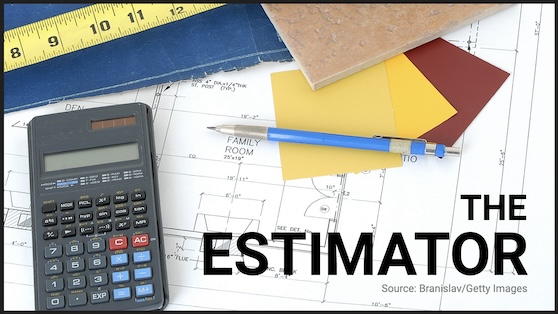
Articles
Business
Features
News
Careers
Lighting & HVAC
The Estimator
Training & Education
Estimating interior and exterior lighting retrofits – The Estimator, October 2023
October 24, 2023 | By John F. Wiesel and Dan Beresford

October 24, 2023 – When you do an accurate estimate, renovations—especially interior and exterior lighting retrofits—can be profitable. But to achieve an accurate estimate and submit a good bid, you must perform a thorough investigation of the site and ask questions! Not every retrofit is the same, yet some contractors feel it is a waste of time to do a site visit (even mandatory ones!).
We’ve seen instances where the electrical drawings referenced work that had to be done, but the work was only shown as notes on the civil or mechanical drawings. A site visit is therefore imperative for making sure you know what the electrical work involves.
On a lighting retrofit, you must understand the scope of the job and the specs:
• Is the customer buying the fixtures from the manufacturer, or are you supplying them? (It is favourable to do a complete supply and installation.)
• If the customer is buying direct, was a survey of fixtures conducted?
• Are all the fixtures specified correctly?
• Who is responsible for the warranty? (If there’s a problem, the manufacturer will blame it on the installation, the installer will blame it on the manufacturer, and so on).
To verify all this information, you must visit the site. Take a fixture survey, and verify the count and location of each type of fixture. Visually inspect and, if necessary, test each fixture to see if it is working.
Is the existing installation up to code? If not, are you responsible for replacing the conduit and wire? When the project involves parking lot lighting, will boring, trenching, or paving work be required? Determine who is responsible for this work. If you, then you will likely require special equipment. Will it be provided for you or form part of your obligation?
Try to get a history of any previous repairs or problems during your site visit. For example, if the existing fixtures require frequent maintenance or replacement, it could suggest the presence of a bigger, underlying problem that goes beyond the fixtures themselves. If you can’t get answers, make a note, and submit an RFI.
Take lots of photos, as they will be valuable when putting together your proposal. And, if your bid is accepted, those same photos can be used to verify the installation.
Some of the potential problems that you may encounter during the installation can only be uncovered on a site visit. For exterior and interior lighting retrofits, consider:
• When the fixtures are high up on a wall, is there room to use a lift?
• In the case of wall-mounted fixtures, who is responsible for repairing and sealing any penetrations into the building?
• If reusing existing lamp poles, are they the right size and in good condition?
• In the case of parking lot lighting, how will you keep cars away from your workers and equipment?
• Are you working in a functioning office? Will the work be carried out during regular business hours, or at night? On weekends?
• Who is responsible for hazardous waste removal, bins, disposal, and recycling? Are disposal certificates required?
For LED lighting retrofits (which is the norm, nowadays), are the existing switches, controls, contactors, etc., compatible with the new installation? If a new control system is not specified, are you responsible for updating the existing one or installing a new one?
Furthermore, it is critical to verify the voltage and amperage ratings. The existing lighting scheme may not match the specified options of 120V, 208V, 277V, 347V, etc., and the emergency lighting could be on another voltage. Has the designer/engineer addressed this?
Finally, the new lighting system will require commissioning and likely some level of training for the customer. If these responsibilities fall to you, then make sure you include them in your estimate.
Profitable jobs start with accurate estimates, so do your due diligence. By visiting the site and asking questions, you will significantly reduce errors and omissions, and eliminate the unexpected from your estimate and bid.
John F. Wiesel is the president of Suderman Estimating Systems Inc., and has been estimating and teaching estimating since the early 1980s. Dan Beresford served as an electrician in the Canadian Navy, then worked in various roles in the electrical sector before joining Suderman.
You’ll find all Back Issues of Electrical Business Magazine in our Digital Archive.
Print this page
